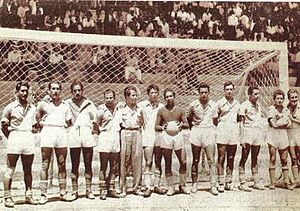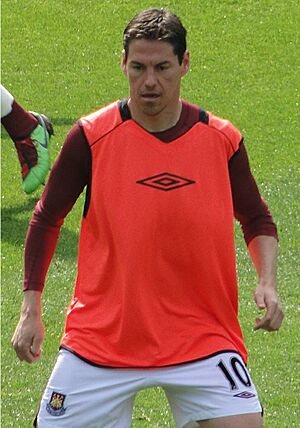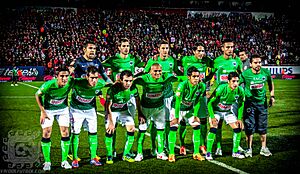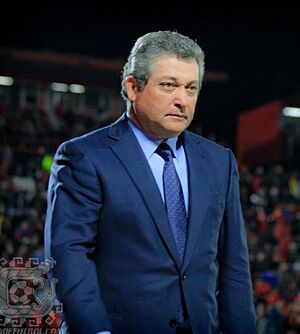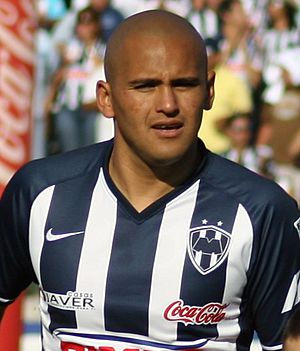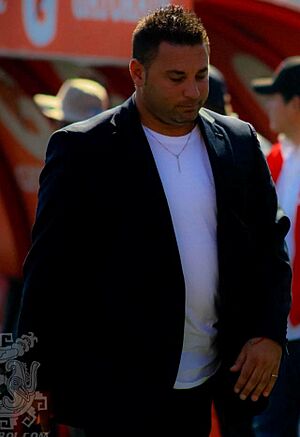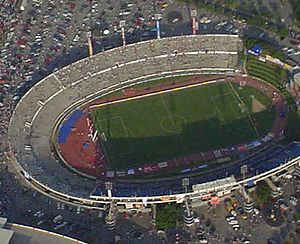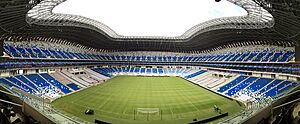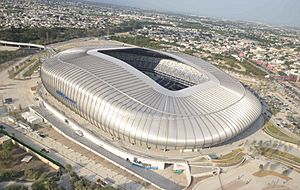C.F. Monterrey facts for kids
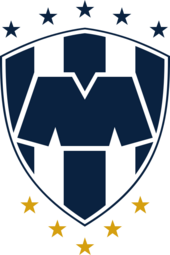 |
||||
| Full name | Club de Fútbol Monterrey Rayados, A.C. | |||
|---|---|---|---|---|
| Nickname(s) | Rayados (Striped-Ones) La Pandilla (The Gang) Los Albiazules (The White-and-Blues) |
|||
| Short name | MTY, CFM | |||
| Founded | 28 June 1945 | |||
| Ground | Estadio BBVA | |||
| Capacity | 53,500 | |||
| Owner | FEMSA | |||
| Chairman | José Antonio Noriega | |||
| Head coach | Domènec Torrent | |||
| League | Liga MX | |||
| Clausura 2025 | Regular phase: 7th Final phase: Quarterfinals |
|||
|
||||
Club de Fútbol Monterrey Rayados, A.C., often called Monterrey or Rayados, is a professional football club from Monterrey metropolitan area, Mexico. They play in Liga MX, which is the top football league in Mexico. The club started in 1945, making it the oldest professional team in northern Mexico. Since 1999, FEMSA, a large bottling company, has owned the club. Their home stadium, Estadio BBVA, opened in 2015. The team's nickname, Rayados, means "Striped-Ones" because of their traditional navy blue striped uniform. The club's logo also shows these stripes, with stars above for league titles and stars below for international wins.
Monterrey has won five league titles and three national cups. They have also won the CONCACAF Champions League five times, including three times in a row from 2011 to 2013. In 2020, Monterrey became only the second Mexican club to win a "continental treble," meaning they won their league, a domestic cup, and a continental championship all in one season.
Their biggest rival is Tigres UANL. The games between them are called the Clásico Regiomontano. This rivalry is known as one of the most exciting in Mexican football. Both teams usually have high attendance at their games and often have some of the most expensive players in the country.
Contents
Club History
Early Years (1940s–1950s)
Club de Football Monterrey was started on June 28, 1945. A group of business people, including Ramón Cárdenas Coronado and Enrique Ayala Medina, founded the team.
The team's nickname, Rayados, became popular because of their uniform. It is usually white with navy blue vertical stripes. The stripes were inspired by another team in 1965, and Monterrey adopted them. Since then, their home uniform has been striped jerseys with blue shorts.
Monterrey won their first professional game 1-0 on August 19, 1945. However, soon after, the team faced a very difficult time. Their bus was in a serious accident, and some players lost their lives. Other Mexican clubs helped by lending players so Monterrey could keep playing. Despite this help, the team struggled and finished last in the league that year. Because of these sad events, the club stopped playing in the league in 1946.
The club returned in 1952, thanks to Dr. Carlos Canseco. They joined the second division and were promoted to the top division just four years later. But they were relegated again after one season. Monterrey was promoted once more in the 1959–60 season and has stayed in the top division ever since.
The 1960s
The 1960s started tough for the club. They barely avoided being sent down to a lower league in the 1960–61 season. They were also close to relegation the next year.
In the 1962–63 season, the team finally had a good year, finishing 5th in the league. They improved even more in the 1963–64 season, finishing 3rd. For the next two seasons, they also finished high, almost winning titles. The 1966–67 season was not as good, and the club finished in the middle of the league.
The 1970s
In 1970, the league was split into two short tournaments because of the 1970 FIFA World Cup in Mexico. Monterrey finished 2nd in their group in the first stage. The next year, they were runners-up to Club América.
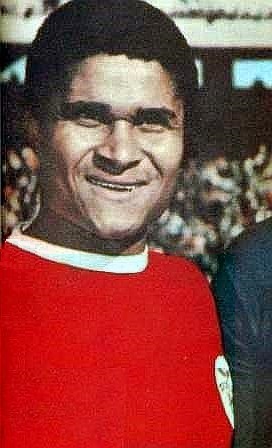
In the 1971–72 season, the club made it to the playoffs but lost in the quarterfinals. They missed the playoffs the following year. In the 1974–75 season, they reached the quarterfinals again but were eliminated.
Monterrey played its first international game on July 5, 1975. They won 2-0 against a Canadian club in the 1975 CONCACAF Champions' Cup. In the 1975–76 season, the club finished first in the regular season. They won their quarterfinal match but lost in the semifinals. During 1975, the famous Portuguese player Eusébio played for the club for a short time.
The club did not make the playoffs in the 1976–77 and 1977–78 seasons. In 1978–79, they qualified for the playoffs again, finishing first in their group. They played in a short tournament with the best eight teams but finished 3rd in their group. The 1970s ended with Monterrey showing great effort but not yet winning a league title.
The 1980s
In 1986, Monterrey won their first ever Liga MX title. The Mexican league was split into two short tournaments that year because of the 1986 FIFA World Cup. In the México 86 tournament, led by coach Francisco Avilán, the team finished first in their group. They easily won their quarterfinal and semifinal matches. In the final, Rayados defeated Tampico Madero 3-2 to claim their first championship.
In 1989, the official anthem of Rayados was created by composer Luis Aguilé. Fans consider it a very important symbol of the team.
The 1990s
At the start of the 1990s, Monterrey signed two well-known players, Carlos Hermosillo and Manuel Negrete. In the 1991–92 season, they won their first Copa MX (Mexico Cup). They then reached the league final in the 1992–93 season but lost.
While the early 1990s looked promising, the second half of the decade was tough due to money problems. The club had to sell many talented players. One of the most remembered moments was the "Clasico del Descenso" in 1996. On March 24, 1996, Monterrey beat their rivals Tigres 2-1. This loss meant Tigres was relegated to a lower division for the first time.
In 1999, Monterrey itself was fighting to avoid relegation. On May 9, 1999, they played Puebla in a crucial match. Monterrey needed a tie to stay in the top division. With a great performance from Francisco Javier Cruz, who helped them win their first title, Monterrey tied 1-1 and stayed in the league. Also in 1999, Rayados played in the CONMEBOL Libertadores for the first time.
The 21st Century
In 2002, Monterrey hired Argentinian coach Daniel Passarella. They built a strong team with players like Guillermo Franco, Walter Erviti, Jesus Arellano, and Luis Perez. In the Clausura 2003 tournament, they won their first official title of the new century. In the semifinals, they faced their rivals Tigres in the playoffs for the first time. Monterrey won the first game 4-1 and advanced to the finals. On June 14, 2003, they defeated Monarcas Morelia 3-1 to win their second league title after 17 years.
After Passarella left in 2004, Miguel Herrera became coach. He led them to the finals in Apertura 2004 and Apertura 2005, but they lost both times. After the 2005 loss, Guillermo Franco left the club. Herrera was fired in 2007. For Clausura 2008, Monterrey hired Ricardo La Volpe. They reached the semifinals with new players like Humberto Suazo and Jared Borgetti.
The Vucetich Era (2009–2013)
In 2009, Monterrey hired coach Víctor Manuel Vucetich. He built one of the strongest teams in the league. Key players included Humberto Suazo, Aldo de Nigris, Luis Ernesto Perez, Jesus Arellano, Walter Ayovi, Jose Maria Basanta, Duilio Davino, and goalkeeper Jonathan Orozco. They won their third league title, the Apertura 2009 tournament, by beating Cruz Azul 6-4 in the finals.
In the next tournament, Humberto Suazo left for a Spanish club. Even without him, Monterrey finished first in the league for the first time. However, they were eliminated in the quarterfinals. Suazo returned for the Apertura 2010 tournament, and they won their fourth league title. They defeated Santos Laguna 5-3 in the finals, with Suazo and Jose Basanta scoring important goals.
Monterrey then qualified for the 2010–11 CONCACAF Champions League. They won the tournament for the first time, beating Real Salt Lake 3-2 in the finals. This was their third title under Vucetich.
The following year, they reached the finals of both the Clausura 2012 league tournament and the 2011–12 CONCACAF Champions League. Both finals were against Santos Laguna. They lost the league final but won the Champions League final, claiming their second straight CONCACAF title.
Monterrey reached the finals of the 2012–13 CONCACAF Champions League for the third time in a row. They faced Santos Laguna again. After a 0-0 draw in the first game, Santos took a 2-0 lead in the second. But Monterrey made an amazing comeback, scoring four goals in 30 minutes. Goals from Aldo de Nigris, Humberto Suazo, and Neri Cardozo gave Monterrey their third consecutive CONCACAF Champions League title. This made them one of the best Mexican football teams ever.
The 2013–14 season brought many changes. Key players like Aldo de Nigris and Walter Ayovi left. Older players like Jesus Arellano and Duilio Davino had retired. New players joined, but a series of poor results led to Vucetich stepping down as coach on August 25, 2013. This ended the Vucetich Era, which brought five titles in four years.
After Vucetich (2013–2015)
José Guadalupe Cruz became the new manager. They reached the semifinals of the domestic cup but missed the playoffs in the Apertura 2013 tournament. After a bad start to Clausura 2014, Cruz was fired.
Carlos Barra took over as coach. Monterrey missed the playoffs again but kept Barra for the 2014–15 season. Colombian striker Dorlan Pabon returned, and with new players, Monterrey had high hopes for Apertura 2014. They finished 6th and returned to the playoffs. The team had a strong attack with Dorlan Pabon and Humberto Suazo. They reached the semifinals but lost to Club América. These were Suazo's last games with the club before he returned to Colo-Colo. Suazo had scored over 102 league goals and was the club's all-time top scorer at that time.
The team started Clausura 2015 poorly. On February 15, Barra was fired, and Antonio Mohamed became the new coach. Mohamed had played for Rayados and helped them avoid relegation in 1999. Monterrey did not make the playoffs under Mohamed that season, but the club decided to keep him. The 2015–16 season was special because the team moved to their new home, the Estadio BBVA Bancomer. New players like Walter Gargano and Rogelio Funes Mori joined, and former players like Jose Maria Basanta, Aldo de Nigris, and Luis Ernesto Pérez returned. Young defender Cesar Montes also joined the first team. Monterrey had a powerful attacking trio of Dorlan Pabon, Rogelio Funes Mori, and Edwin Cardona.
Antonio Mohamed's Time (2015–2018)
In the winter of 2016, the team brought back veteran Walter Ayovi and signed Carlos Sánchez. The team started the Clausura 2016 tournament very well, winning their first three games. They had their best regular season in years, finishing first in the league. Their strong attack, with Pabon, Funes Mori, and Cardona, was key to their success.
Monterrey entered the playoffs as favorites. In the quarterfinals, they faced their rivals Tigres. Monterrey won the first game 3-1 and advanced with a 4-3 total score. They continued their record of never being eliminated by Tigres in the playoffs. In the semifinals, they beat Club América in an exciting 4-2 victory. They reached the league finals against Pachuca. A key player, Carlos Sanchez, could not play in the finals because he was called up by his national team. Monterrey lost the first game 1-0. The second game was played at their new stadium, Estadio BBVA Bancomer, which was its first final. On May 29, 2016, Monterrey scored first, but Pachuca scored in the last minutes to win the title. This was a heartbreaking loss for Monterrey.
The next tournament, Apertura 2016, was disappointing as they missed the playoffs. They also returned to the CONCACAF Champions League but were surprisingly eliminated in the group stage.
In the Apertura 2017 season, Monterrey finished first in the regular season. They easily won their quarterfinal and semifinal matches. They advanced to the final against their arch-rival Tigres. The first game was a 1-1 tie. In the second game at Estadio BBVA Bancomer, Tigres beat Monterrey 2-1 to win the title. In May 2018, Mohamed resigned after being eliminated from the Clausura 2018 playoffs. He won two titles but was criticized for losing important playoff games.
Diego Alonso's Time (2018–2019)
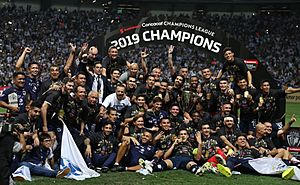
Diego Alonso became the new coach in July 2018. The club had a great run in the Copa MX, reaching the final but losing to Cruz Azul. Monterrey finished high in both the Clausura and Apertura Liga MX seasons, earning playoff spots. They reached the semifinals in both playoffs but were eliminated. In the CONCACAF Champions League, they won the tournament after beating Sporting Kansas City and then their rivals Tigres in the final. This championship was very important to the city, as it felt like revenge for the domestic final loss to Tigres. It is known as "the star that shines the most."
In the Apertura 2019 season, Diego Alonso was dismissed as coach because the team had more losses than wins.
Antonio Mohamed Returns (2019–2020)
On October 14, Antonio Mohamed was reappointed as manager. The club had a good run in the FIFA Club World Cup, reaching the semifinals after beating Al Sadd. They were eliminated by Liverpool but then beat Al Hilal to win a third-place medal. In the same month, even though the club finished 8th in the Apertura league table, they reached the championship finals against Club América. They defeated them in a penalty shootout, winning 4-2, and secured their fifth league championship trophy.
Club Culture
Colours
Since the club started in 1945, their main colors have been white and blue. The shade of blue has changed over time, from dark navy to lighter tones. Sometimes, a third color like red, orange, cyan, violet, purple, or green has been used.
Young Player Development
The club has always focused on developing its own young players, known as cantera. Many international players have come from Monterrey's youth system. These include Francisco Javier Cruz, Jesús Arellano, Jonathan Orozco, Hiram Mier, Jesús Manuel Corona, César Montes, and Carlos Rodríguez.
Rivalry
Rayados' biggest rival is Tigres UANL. Their rivalry is called the Clásico Regiomontano. Both Monterrey and Tigres are famous for selling out all their home games. For Clásico matches, tickets sell out very quickly. This rivalry is considered the most intense in Mexican football.
As of August 2022, there have been 128 official Clásico games. Tigres has won 47, Monterrey has won 42, and 39 games have been ties. The first Clásico was on July 13, 1974, and ended in a 1-1 draw. Monterrey won the second Clásico 2-1.
Monterrey also has a regional rivalry with Santos Laguna. They have played four finals against each other, with Monterrey winning three. This rivalry is sometimes called "La Nortena."
Fan Base
Los Rayados supporters always fill the Estadio BBVA Bancomer. In 2016, they had the highest average attendance in Liga MX, with 50,000 fans per game. The city of Monterrey is known for having very loyal football fans. There is a strong rivalry between La Adicción, Monterrey's main fan group, and Libres y Lokos, Tigres UANL's fan group, especially during Clásico games.
Children's Web Series
In 2017, the club launched a YouTube and YouTube Kids series called Rayados Kids. This series creates content for young fans, including interviews with players and stories about the team. In its first year, the web series gained many subscribers and views.
Rayados Christmas Campaign
Since 2010, Rayados players have made an annual holiday video to wish fans a Merry Christmas. It has become a tradition to include a new version of their famous song "El Corrido de Monterrey" in these videos. This shows fans their passion for the team "En la Vida y en la Cancha" (In Life and on the Field).
Home Stadiums
Monterrey played their home games at the Estadio Tecnológico from 1950 to 2015. For a period from 1973 to 1980, they also played at the Estadio Universitario. The Estadio Tecnológico opened on July 17, 1950. It was the second oldest football stadium in Mexico. It was used for the 1986 FIFA World Cup and could hold 38,000 people. The stadium was demolished starting in July 2017.
In the 1977–78 season, both Tigres and Rayados played at the Estadio Tecnológico. This included the first Clásico Regio derby held there. Monterrey won league titles in 1986 and Apertura 2010 at this stadium. They also won the Copa MX in 1991 and the CONCACAF Champions League in 2012–13 there.
In July 2015, Monterrey moved to a new stadium called Estadio BBVA. It is located in Guadalupe, Nuevo León. The new stadium can hold 53,500 people. It has features similar to famous stadiums like England's Wembley Stadium. The stadium opened on August 2, 2015, with a friendly match where Monterrey beat Benfica 3-0 in front of a sold-out crowd.
Estadio BBVA was designed by Christopher Lee. Its construction started in October 2011. The stadium was built by FEMSA and cost about US$200 million. It is considered one of the most beautiful stadiums in Mexico and has the fourth largest capacity. It has a real grass field, luxury suites, a club restaurant, and a club lounge. The stands are steeply angled to give fans a great view of the action.
On May 29, 2016, Monterrey played their first final in their new stadium. They faced Pachuca for the Clausura 2016 championship. They tied 1-1 but lost 2-1 overall.
Team Kits and Sponsors
Kit Evolution
The first uniform in 1945 had a diagonal split shirt with blue and white, white shorts, and navy blue socks. In 1955, after winning the second division, the club used a white shirt with two horizontal blue lines. In the 1960s, they wore a kit with vertical baby blue lines. In 1962, D. José Ramón Ballina introduced the striped kit that the club still uses today, inspired by another team.
In the 1970s, many different designs appeared, some with wider stripes or blue and black colors. The biggest change happened in the mid-1980s when the shirt color changed from royal blue to the navy blue used now.
Atletica made the kits from 1999 to 2007. Then, American company Nike made them from 2007 to 2014. After that, Monterrey signed a contract with German company Puma, which has been making the team's kits ever since.
Sponsors
| Year | Manufacturer | Main Sponsor | Other Sponsors |
|---|---|---|---|
| 1984–91 | Adidas | ||
| 1991–98 | Aba Sport | ABACO-CONFIA 1989–98 | AGUA SPORT |
| 1998–99 | Aba Sport | Bimbo | AGUA SPORT, Pepsi and Tecate |
| 1999–07 | Atletica | Bimbo | Coca-Cola, Casas Javer, Oxxo, Carta Blanca and BBVA Bancomer |
| 2007–08 | Nike | Bimbo | Coca-Cola, Casas Javer, LG, Carta Blanca and BBVA Bancomer |
| 2008–13 | Nike | Bimbo | Coca-Cola, Casas Javer, Carta Blanca, Berel, The Home Depot and BBVA Bancomer |
| 2014–2016 | Puma | Bimbo | Coca-Cola, Tecate, The Home Depot, AeroMéxico, H-E-B, Berel, HaVital Casas, Carl's Jr and BBVA Bancomer |
| 2016–2017 | Puma | BBVA Bancomer | Coca-Cola, Tecate, The Home Depot, Cemex, H-E-B, Berel, HaVital Casas, AT&T and Hagamoslo Bien |
| 2017–2019 | Puma | AT&T | Coca-Cola, Tecate, The Home Depot, Cemex, H-E-B, Berel, Hagámoslo Bien, Chilchota Alimentos, MAN SE, Vidusa and BBVA Bancomer |
| 2019–2021 | Puma | AT&T | Coca-Cola, Tecate, The Home Depot, H-E-B, Berel, Hagámoslo Bien, Oxxo Gas, Chilchota Alimentos, CREST México, MAN SE, Vidusa and BBVA Mexico |
| 2021–2022 | Puma | Codere | Coca-Cola, Tecate, The Home Depot, H-E-B, Berel, Hagámoslo Bien, Oxxo Gas, Roshfrans, Chilchota Alimentos, CREST México, Vidusa and BBVA Mexico |
| 2022– | Puma | Codere | Coca-Cola, Tecate, H-E-B, Berel, Hagámoslo Bien, Oxxo Gas, Roshfrans, Chilchota Alimentos, Carl's Jr., CREST México, Vidusa and BBVA Mexico |
Club Honours
National Titles
| Type | Competition | Titles | Winning editions | Runners-up |
|---|---|---|---|---|
Top division |
Primera División/Liga MX | 5 | México 1986, Clausura 2003, Apertura 2009, Apertura 2010, Apertura 2019 | 1992–93, Apertura 2004, Apertura 2005, Clausura 2012, Clausura 2016, Apertura 2017, Apertura 2024 |
| Copa México/Copa Presidente/Copa MX | 3 | 1991–92, Apertura 2017, 2019–20 | 1963–64, 1968–69, Apertura 2018 | |
| Campeón de Campeones | 0 | – | 2003 | |
| Supercopa MX | 0 | – | 2018 | |
| Promotion division | Segunda División | 2 | 1955–56, 1959–60 | 1957–58, 1958–59 |
| Copa de la Segunda División | 0 | – | 1957–58 | |
| Campeón de Campeones de la Segunda División | 1 | 1960 | 1956 |
International Titles
| Type | Competition | Titles | Winning editions | Runners-up |
|---|---|---|---|---|
| CONCACAF Champions League | 5 | 2010–11, 2011–12, 2012–13, 2019, 2021 | – | |
| CONCACAF Cup Winners Cup | 1s | 1993 | – |
- Notes
- record
- s shared record
Friendly Titles
- Eusébio Cup: 2015
- Los Angeles Nations Cup: 1991
- Copa Gobernador de Nuevo León: 1992
- Copa Rial: 1995
- Copa Movistar: 2002
- International Challenge Cup: 2003
- Torneo de Verano Miller Lite: 2004
- Copa Chiapas: 2006
- Chicago Mayor's Cup (1): 2009
- Copa del Pacífico: 2024
Club Personnel
Management Team
| Position | Staff |
|---|---|
| Sporting Chairman | |
| Corporate Chairman | |
| Coordinator of football | |
| Director of academy |
Source: Liga MX
Coaching Staff
Players
First Team Squad
|
|
Other Players Under Contract
|
Players Out on Loan
|
|
Reserve Teams
Top Scorers
|
FMF: Liga MX
CUP: Copa MX
CON: CONCACAF Champions League
REC: Recopa de la Concacaf
CWC: FIFA Club World Cup
Most Appearances
- Players in bold are currently active with Club de Fútbol Monterrey.
- Does not count appearances in international competitions.
Managers
 Roberto Scarone (1962–65)
Roberto Scarone (1962–65) Mario Perez (1966–69)
Mario Perez (1966–69) Ignacio "El Gallo" Jáuregui (1969–74)
Ignacio "El Gallo" Jáuregui (1969–74) Fernando Riera (1975–76)
Fernando Riera (1975–76) Bira (1976)
Bira (1976) Luis Firpo (1976–77)
Luis Firpo (1976–77) Fernando Riera (1977–78)
Fernando Riera (1977–78) Otto Glória (1978–79)
Otto Glória (1978–79) Gustavo Peña (1979)
Gustavo Peña (1979) Bira (1979–80)
Bira (1979–80) Pedro Dellacha (1980–81)
Pedro Dellacha (1980–81) Héctor Hugo Eugui (1981–82)
Héctor Hugo Eugui (1981–82) Vicente Pereda (1982–83)
Vicente Pereda (1982–83) Roberto Matosas (1983–84)
Roberto Matosas (1983–84) Francisco Avilán (1984–87)
Francisco Avilán (1984–87) José Ledezma (1987–89)
José Ledezma (1987–89) Fernando Riera (1989)
Fernando Riera (1989) Pedro García (1989–91)
Pedro García (1989–91) Carlos Alberto Torres (1991–92)
Carlos Alberto Torres (1991–92) Miguel Mejía Barón (1 July 1991 – 30 June 93)
Miguel Mejía Barón (1 July 1991 – 30 June 93) Hugo Hernández (1993–94)
Hugo Hernández (1993–94) Magdaleno Cano (1994), (1997), (1999)
Magdaleno Cano (1994), (1997), (1999) Arturo Salah (1 July 1994 – 30 June 97)
Arturo Salah (1 July 1994 – 30 June 97) Claudio Lostanau (1997)
Claudio Lostanau (1997) Tomás Boy (1 July 1997 – 30 June 98)
Tomás Boy (1 July 1997 – 30 June 98) José Treviño (22 Jan 1999 – 1 March 99)
José Treviño (22 Jan 1999 – 1 March 99) Carlos Jara Saguier (4 March 1999 – 30 June 99)
Carlos Jara Saguier (4 March 1999 – 30 June 99) Eduardo Solari (1999)
Eduardo Solari (1999) Benito Floro (12 Nov 1999 – 30 June 2001)
Benito Floro (12 Nov 1999 – 30 June 2001) Daniel Passarella (1 July 2002 – 31 Dec 2003)
Daniel Passarella (1 July 2002 – 31 Dec 2003) Hugo de León (2004)
Hugo de León (2004) Sergio Orduña (20 April 2004 – 30 June 2004)
Sergio Orduña (20 April 2004 – 30 June 2004) Miguel Herrera (1 July 2004–16 Sept 2007)
Miguel Herrera (1 July 2004–16 Sept 2007) Isaac Mizrahi Smeke (1 Oct 2007 – 10 Jan 2008)
Isaac Mizrahi Smeke (1 Oct 2007 – 10 Jan 2008) Ricardo La Volpe (12 Jan 2008 – 8 Jan 2009)
Ricardo La Volpe (12 Jan 2008 – 8 Jan 2009) Víctor Manuel Vucetich (9 Jan 2009 – 26 Aug 2013)
Víctor Manuel Vucetich (9 Jan 2009 – 26 Aug 2013) José Guadalupe Cruz (27 Aug 2013 – 18 Feb 2014)
José Guadalupe Cruz (27 Aug 2013 – 18 Feb 2014) C. Barra & J. Treviño (interim) (19 Feb 2014 – 16 May 2014)
C. Barra & J. Treviño (interim) (19 Feb 2014 – 16 May 2014) Carlos Barra (16 May 2014 – 15 February 2015)
Carlos Barra (16 May 2014 – 15 February 2015) Antonio Mohamed (16 February 2015 – 7 May 2018)
Antonio Mohamed (16 February 2015 – 7 May 2018) Diego Alonso (18 May 2018 – 30 September 2019)
Diego Alonso (18 May 2018 – 30 September 2019) Antonio Mohamed (9 October 2019 – 25 November 2020)
Antonio Mohamed (9 October 2019 – 25 November 2020) Javier Aguirre (7 December 2020 – 26 February 2022)
Javier Aguirre (7 December 2020 – 26 February 2022) Víctor Manuel Vucetich (2 March 2022 – 28 May 2023)
Víctor Manuel Vucetich (2 March 2022 – 28 May 2023) Fernando Ortíz (29 May 2023 – 6 August 2024)
Fernando Ortíz (29 May 2023 – 6 August 2024) Martín Demichelis (12 August 2024 – 11 May 2025)
Martín Demichelis (12 August 2024 – 11 May 2025) Domènec Torrent (21 May 2025 – present)
Domènec Torrent (21 May 2025 – present)
See also
 In Spanish: Club de Fútbol Monterrey para niños
In Spanish: Club de Fútbol Monterrey para niños


